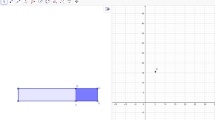Abstract
This paper describes a study of the cognitive complexity of young students, in the pre-formal stage, experiencing the dragging tool. Our goal was to study how various conditions of geometric knowledge and various mental models of dragging interact and influence the learning of central concepts of quadrilaterals. We present three situations that reflect this interaction. Each situation is characterized by a specific interaction between the students’ knowledge of quadrilaterals and their understanding of the dragging tool. The analyses of these cases offer a prism for viewing the challenge involved in changing concept images of quadrilaterals while lacking understanding of the geometrical logic that underlies dragging. Understanding dragging as a manipulation that preserves the critical attributes of the shape is necessary for constructing the concept images of the shapes.
Similar content being viewed by others
References
Arzarello F., Olivero F., Paola D., Robutti O. (2002). A cognitive analysis of dragging practices in Cabri environments. ZDM 34(3):66–72
Battista M.T. (2001). Shape Makers: A computer environment that engenders students’ construction of geometric ideas and reasoning. In: Tooke J., Henderson N. (eds), Using Information Technology in Mathematics Education. New York, Haworth Press, pp. 105–120
Burger W.F., Shaughnessy J.M. (1986). Characterizing the van Hiele levels of development in geometry. Journal for Research in Mathematics Education 17(1):31–48
Choi Koh S.S. (1999). A Student’s learning of geometry using the computer. The Journal of Educational Research 92(5):301–311
Currie, P. and Pegg, J. (1998). Investigating students understanding of the relationships among quadrilaterals. In C. Kanes, M. Goos and E. Warren (Eds). Teaching Mathematics in New Times, Proceedings of the Annual Conference of the Mathematics Education Research Group of Australia Incorporated. Vol. 1. (pp. 177–184)
de Villiers M. (1994). The role and function of a hierarchical classification of quadrilaterals. For the Learning of Mathematics 14(1):11–18
English L.D. (1997). Mathematical Reasoning: Analogies, Metaphors and Images. Hillsdale, New Jersey, Lawrence Erlbaum Associates
Fischbein E. (2001). Tacit models and infinity. Educational Studies in Mathematics 48:309–329
Geddes, D., Fuys, D., Lovett, J. and Tischler, R. (1982). An investigation of the van Hiele model of thinking in geometry among adolescents. Paper presented at the Annual Meeting of the American Educational Research Association, New York
Hasegawa J. (1997). Concept formation of triangles and quadrilaterals in the second grade. Educational Studies in Mathematics 32:157–179
Hershkowitz R. (1990). Psychological aspects of learning geometry. In: Nesher P., Klipatric J. (eds), Mathematics and Cognition. Cambridge, Cambridge University Press, pp. 70–95
Healy L., Hoyles C. (2001). Software tools for geometrical problem solving: Potentials and pitfalls. International Journal of computers for Mathematical Learning 6:235–256
Jackiw N., Finzer F.W. (1993). The Geometer’s Sketchpad : Programming by geometry. In: Cypher I. (eds), Watch What I Do: Programming by Demonstration. Cambridge, London, The MIT Press, pp. 293–308
Johnson-Laird P.N. (1983). Mental Models. Cambridge, Cambridge University Press
Jones K. (2000). Providing a foundation for deductive reasoning: Student’s interpretations when using dynamic geometry software and their evolving mathematical explanations. Educational Studies in Mathematics 44:55–85
Laborde C., Laborde J.M. (1995). What about a learning environment where Euclidean concepts are manipulated with a mouse? In: diSessa A.A., Hoyles C., Noss R., Edwards L.D. (eds), Computers and Exploratory Learning. Berlin, Springer, pp. 241–262
Markman E.M. (1989). Categorization and Naming in Children. Cambridge, London, The MIT Press
Maymon Erez, M. The development of young students understanding of hierarchical relations between geometrical concepts, while learning with Dynamic Geometry Environments. PhD dissertation, University of Haifa, Faculty of Education (in Hebrew) (in preparation)
Monaghan F. (2000). What difference does it make? Children views of the difference between some quadrilaterals. Educational Studies in Mathematics 42(2):179–196
Norman D.A. (1983). Some observations on mental models. In: Gentner D., Stevens A.L. (eds), Mental Models. Hillsdale, New Jersey, Lawrence Erlbaum Associates, pp. 7–14
Parzysz B. (1988). “Knowing” vs. “seeing”: problems of the plane representation of space geometry figure. Educational Studies in Mathematics 19(1):79–92
Pratt D., Ainley J. (1997). The construction of meanings for geometric construction: Two contrasting cases. International Journal of Computers for Mathematical Learning 1(3):293–322
Schwartz J. (1995). The right size byte: Reflections of an educational software designer. In: Perkins D.N., Schwartz J., West M.L., Wiske M.S. (eds), Software Goes to School. New York, Oxford, Oxford University Press, pp. 172–181
Senk S.L. (1989). Van Hiele levels and achievement in writing geometry proofs. Journal for Research in Mathematics Education 20(3):309–321
Usiskin Z. (1982). Van Hiele Levels and Achievement in Secondary School Mathematics. Chicago, University of Chicago, Department of Education
Van Hiele, P.M. (1959). The child’s thought and geometry. In D.G. Fuys and R. Tischler (Eds), (1985), English translation of selected writings of Dina van Hiele - Geldof and Pierre M van Hiele (pp. 243–252). Brooklyn, NY: Brooklyn College School of Education
Vincent, J. and McCrea, B. (1999). Cabri geometry: A catalyst for growth in geometry understanding. In J.M. Truran and K.M. Truran (Eds), Proceeding of 22nd Conference of Mathematics Education Research Group of Australia (pp. 507–514)
Vinner S. (1983). Concept definition, concept image and the notion of function. International Journal of Mathematical Education in Science and Technology 14:293–305
Vygotsky L.S. (1978). Mind in Society: The Development of Higher Psychological Processes. Cambridge, MA, Harvard University Press
Yerushalmy M. (1999) Making Exploration Visible: On Software Design and School Algebra Curriculum. International Journal for Computers in Mathematical Learning 4(2–3):169–189
Author information
Authors and Affiliations
Corresponding author
Rights and permissions
About this article
Cite this article
Erez, M.M., Yerushalmy, M. “If You Can Turn a Rectangle into a Square, You Can Turn a Square into a Rectangle ...” Young Students Experience the Dragging Tool. Int J Comput Math Learning 11, 271–299 (2006). https://doi.org/10.1007/s10758-006-9106-7
Received:
Accepted:
Published:
Issue Date:
DOI: https://doi.org/10.1007/s10758-006-9106-7




